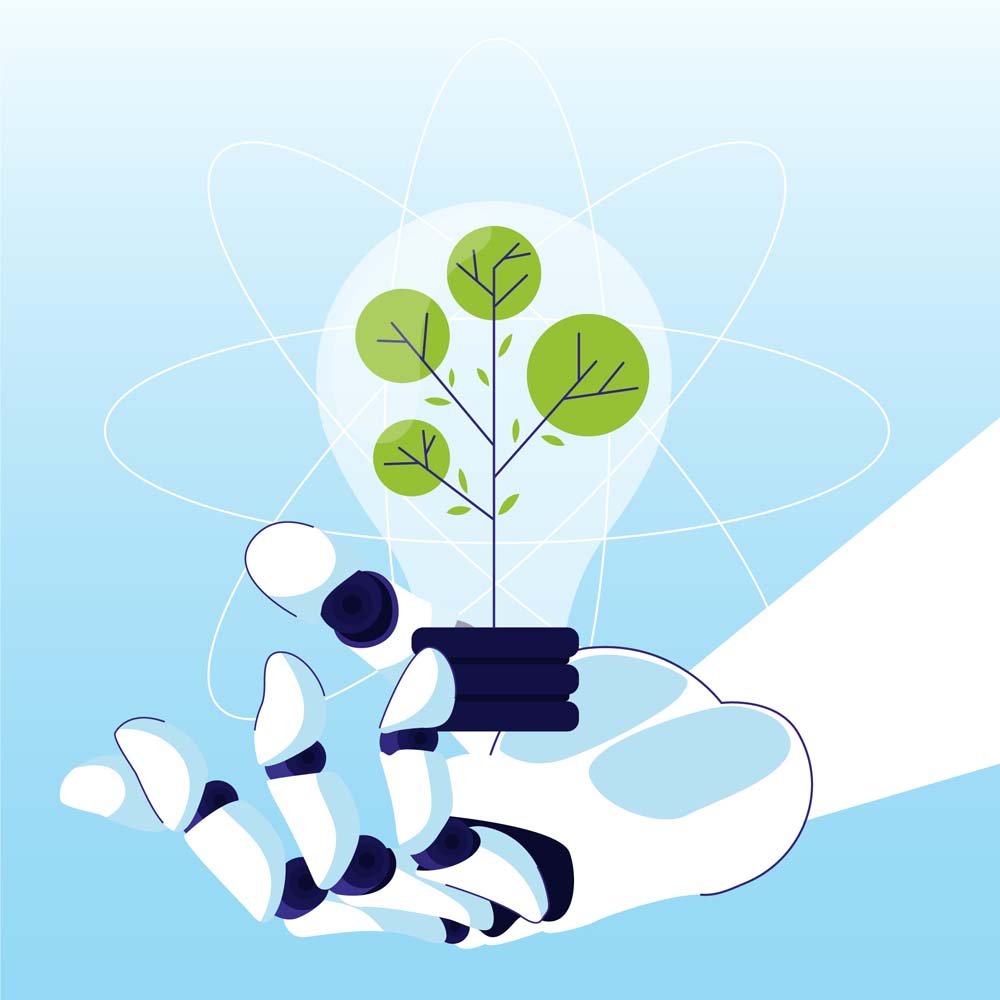In a remote forest, drones equipped with artificial intelligence (AI) patrol the sky. Their mission? To identify forest fires in their early stages and alert firefighters before the flames spread. This scenario is not science fiction; in places like California, this technology is already helping to prevent environmental disasters and save lives. This case exemplifies the alliance of artificial intelligence and sustainability in addressing some of the most critical challenges of our time.
As AI technologies advance, their integration into sustainability strategies becomes more sophisticated and effective. These advancements enable deeper and more accurate data analysis, facilitating informed decision-making in near real-time. Here are eight key areas where AI can significantly contribute to a more sustainable world.
In this article we address the following topics:
- AI and sustainability in precision agriculture
- Optimization of renewable energies
- Smart grid management
- Climate change modeling
- Wildlife conservation
- AI in construction
- Waste management
- Water management
1. Artificial intelligence and sustainability in precision agriculture
In agriculture, AI analyzes data from sensors, satellite images, and weather forecasts to optimize resource use. This reduces water consumption, minimizes pesticide use, and increases crop yields. These practices not only enhance efficiency but also promote more sustainable and environmentally friendly farming.
Example: The European Commission, through its Horizon 2020 program, funds precision agriculture projects that use AI to improve crop management. One such project, IoF2020 (Internet of Food & Farm 2020), utilizes AI sensors and algorithms to monitor soil and weather conditions. The goal is to optimize irrigation and fertilization to reduce resource use and boost productivity.
2. Renewable energy optimization
AI algorithms predict energy production from renewable sources such as wind and solar, facilitating their integration into the power grid. This efficiency reduces dependence on fossil fuels and enhances grid stability. Additionally, AI helps manage energy storage, maximizing the use of renewable resources.
Example: Google uses AI to forecast solar and wind power production in its data centers, enabling it to adjust electricity consumption based on the availability of renewable energy.
3. Smart grid management
AI manages electricity distribution through smart grids to balance supply and demand in real time. This improves energy efficiency and facilitates the integration of renewable energy. Smart grids can also detect and respond to faults more quickly, resulting in reduced downtime and a more robust power system.
Example: The city of Copenhagen has implemented an advanced smart grid system that leverages AI to optimize electricity distribution. This system integrates data from numerous sensors and smart meters across the city to monitor and manage energy usage dynamically. By using AI algorithms, Copenhagen’s smart grid can efficiently balance supply and demand, incorporate renewable energy sources like wind and solar, and quickly detect and address outages or inefficiencies.
4. Climate change modeling
AI-powered climate models provide more accurate predictions of climate change impacts. This approach is especially useful as climate predictions are some of the most complex computational processes. AI and sustainability work together in analyzing vast amounts of historical and current climate data to identify patterns and trends.
Example: IBM has developed an AI-based climate model called the IBM Environmental Intelligence Suite, which analyzes global climate data to improve predictions and help mitigate the effects of climate change.

5. Wildlife conservation
AI analyzes data from camera traps, drones, and satellites to monitor wildlife populations and detect poaching activities. This technology is crucial for protecting endangered species and preserving their habitats. AI systems can automatically identify specific animals and alert conservationists to potential threats in real time.
Example: Wildlife Insights is a platform used by conservation organizations worldwide with AI-based technologies. Using machine learning, it analyzes millions of camera trap images to identify species and help conservationists monitor biodiversity.
6. AI in construction
In the planning and construction of buildings, AI can improve energy efficiency and reduce material waste. This technology allows for the design of more sustainable structures and the prediction of problems before they occur, reducing costs and minimizing environmental impact.
7. Waste management
AI-powered robots and sorting systems enhance recycling processes by accurately identifying and separating different types of waste. This increases recycling rates and reduces the amount of waste going to landfill. AI can also optimize waste collection routes, reducing fuel consumption and greenhouse gas emissions.
Example: ZenRobotics has developed an AI-based waste sorting system that uses robots to identify and separate recyclable materials, improving efficiency and reducing the required labor.
8. Water management
AI systems monitor water quality and manage distribution networks to detect leaks and predict maintenance needs. This conserves water and ensures its sustainable use. As noted in the first section, AI can also optimize irrigation in agriculture to ensure crops receive the exact amount of water needed, improving water efficiency.
Example: ACCIONA has developed the intelligent water management system known as BIONS, which uses artificial intelligence to monitor and optimize the operation of water distribution networks in real-time. This system integrates data from sensors distributed throughout the network to detect leaks, predict failures, and optimize water distribution.
The synergy between AI and sustainability is facilitating the transition to a more sustainable and environmentally friendly economy. These innovations not only improve efficiency and reduce environmental impact but also open up new development opportunities. If you want to learn more about these technologies, you can subscribe to our newsletter at the bottom of this page.
Sources:



